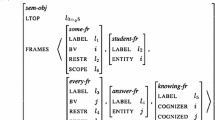Abstract
It has long been known that language acquisition is only possible if information is available above and beyond the mere presence of a set of strings in the language. One commonly postulated source of such information is a (possibly innate) constraint on the syntactic forms that a grammar can take. This paper develops and presents a set of formalisms based on the Marker Hypothesis that natural languages are “marked” for complex syntactic structure at surface form. It further compares the expressivity and restrictedness of these formalisms and shows that, first, not all constraints are actually restrictive, and second, that the Marker Hypothesis, and its implicit function/content word distinction, provide strong restrictions on the form of allowable grammars. These restrictions may in turn provide evidence about its actual psychological reality and salience. In particular, the class of strongly marked languages can be demonstrated not to admit all finite languages and thus not be subject to the hangman's noose of Gold's learnability proofs, and it is conjectured that these languages may provide a computable method of inferring human-like languages.
Similar content being viewed by others
References
Angluin, D. Inductive inference of formal languages from positive data. Information and Control, 45: 117-135, 1980.
Berlin, B. and P. Kay. Basic Color Terms: Their Universality and Evolution. University of California Press. Berkeley, California, 1969.
Berwick, R. C. and S. Pilato. Learning syntax by automata induction. Machine Learning, 2: 9-38, 1987.
Brown, P. F., J. Cocke, S. A. Della Pietra, V. J. Della Pietra, F. Jelinek, J. D. Lafferty, R. L. Mercer and P. S. Roossin. A statistical approach to machine translation. Computational Linguistics, 16: 79-85, 1990.
Carroll, G. and E. Charniak. Learning probabilistic dependency grammars from corpora. In Working Notes, Fall Symposium Series, 25-32, 1992a, AAAI. Cited in (Charniak, 1993).
Carroll, G. and E. Charniak. Two experiments on learning probabilistic dependency grammars from labeled text. In Workshop Notes, Statistically-Based NLP Techniques, 1-13, 1992b, AAAI. Cited in Charniak (1993).
Charniak, E. Statistical Language Learning. MIT Press, Cambridge, MA, 1993.
Chomsky, N. On certain formal properties of grammar. Information and Control, 2: 137-67, 1959.
Chomsky, N. Remarks on nominalization. In Studies on Semantics in Generative Grammar, 11-61, Mouton, The Hague, 1972.
Chomsky, N. Lectures on Government and Binding. Foris Publications, Dordrecht, 1981.
Croft, W. Typology and Universals. Cambridge University Press, Cambridge, 1990.
Dorr, B. J. Machine Translation: A View from the Lexicon. MIT Press, Cambridge, MA, 1993.
Gold, E. M. Language identification in the limit. Information and Control, 10: 447-74, 1967.
Green, T. R. G. The necessity of syntax markers: Two experiments with artificial languages. Journal of Verbal Learning and Verbal Behavior, 18: 481-96, 1979.
Greenberg, J. H. Some universals of grammar with particular reference to the order of meaningful elements. In Joseph H. Greenberg, editor, Universals of Grammar,MIT Press, Cambridge, 1966.
Hopcroft, J. E. and J. D. Ullman. Formal Languages and Their Relation to Automata.Addison-Wesley Publishing Company, Reading, Mass., 1969.
Hopcroft, J. E. and J. D. Ullman. Introduction to Automata Theory, Languages, and Computation. Addison-Wesley Publishing Company, Reading, Mass., 1979.
Jackendorff, R. S. Syntax: A Study of Phrase Structure. MIT Press, Cambridge 1977.
Juola, P. Learning to Translate: A Psycholinguistic Approach to the Induction of Grammars and Transfer Functions. Dissertation, University of Colorado at Boulder, 1995.
Juola, P. Phonetic ambiguity: Approaches, touchstones, pitfalls, and new directions. In Proceedings of the 5th International Conference on the Cognitive Science of Natural Language Processing (CSNLP-96), Dublin, Ireland, 1996.
Juola, P. Corpus-based acquisition of transfer functions using psycholinguistic principles. In Daniel Jones & Harry Somers, editors, New Methods in Language Processing, UCL Press, London, in press.
Keenan, E. and B. Comrie. Noun phrase accessibility and universal grammar. Linguistic Inquiry, 8: 63-99, 1977.
Koncar, N. and G. Guthrie. A natural language translation neural network. In Proceedings of the International Conference on New Methods in Language Processing (NeMLaP), 71-77, Manchester, 1994.
Kornai, A. and G. K. Pullum. The X-bar theory of phrase structure. Technical Report CSLI, 89-137. Centre for the Study of Language and Information, Stanford, CA, 1989.
Lucas, S. M. and R. I. Damper. Syuntactic neural networks. Connection Science, 2: 195-221, 1990.
Maurer, H. A., A. Salomaa and D. Wood. A supernormal form theorm for context-free grammars. Journal of the ACM, 30: 95-102, 1983.
McNeil, D. Development psycholinguistics. In F. Smith and G. A. Miller, editors, The Genesis of Language: A Psycholinguistic Approach, 15-84. MIT Press, Cambridge, MA, 1966.
Morgan, J. L., R. P. Meier and E. L. Newport. Facilitating the acquisition of syntax with cross-sentential cues to phrase structure. Journal of Memory and Language, 28: 360-74, 1989.
Mori, K. and S. D. Moeser. The role of syntax markers and semantic referents in learning an artificial language. Journal of Verbal Learning and Verbal Behavior, 22: 701-18, 1983.
Nagao, M. A framework of a mechanical translation between Japanese and English by analogy principle. In A. Elithorn and R. Barnerji, editors, Artificial and Human Intelligence, 173-80, North-Holland, 1984.
O'Grady, W., M. Dobrovolsky and M. Aronoff. Contemporary Linguistics: An Introduction. St. Martin's Press, New York, 1989.
Pullum, G. K. The Great Eskimo Vocabulary Hoax. University of Chicago Press, 1991.
Slobin D. I. Psycholinguistics, second edition, Scott, Foresman, and Company, Glenview, 1979.
Author information
Authors and Affiliations
Rights and permissions
About this article
Cite this article
Juola, P. On Psycholinguistic Grammars. Grammars 1, 15–31 (1998). https://doi.org/10.1023/A:1009922701408
Issue Date:
DOI: https://doi.org/10.1023/A:1009922701408




